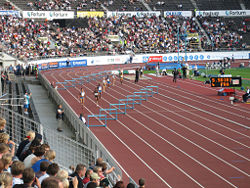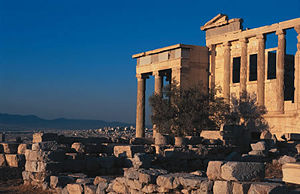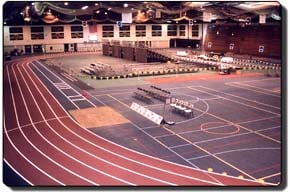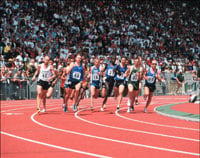Track and field
Athletics also known as track and field or is a collection of sporting events that involve running, throwing, hurdling and jumping. The name is derived from the Greek word "athlon" meaning "contest". The sport of track and field was the building block of the modern day Olympics. What started out more that 2,500 years ago as a single race, has envolved into a sport where over 200 member nations of the IAAF or International Amateur Athletic Federation compete in competition.
History
Ancient Games
While most recognize the Olympic Games as the start of track and field, the most ancient of all the athletic festivals was established in 1829 B.C.E. in Meath, Ireland. The Tailteann Games was an annual thirty day gathering that including foot races, and stone throwing. The event lasted all the way until 1168 C.E. before the Norman invaision.
Athletics was the original event at the first Olympics in 776 B.C.E. where the only event held was the stadium-length 600 foot race or "stade". While 776 B.C.E. is the offical start date for the games, some historians believe they started 600 years earlier. From 776 B.C.E., the Olympic games were held in Olympia every four years for the next 12 centuries. As Greece progressed as a country, so did the Olympic Games as additional races and events were added to the Olympic schedule constantly.
By 5th century B.C.E., the olympics had expanded to become a five-day event with multiple event catagories. There were three foot races of stadion, diaulos, and dolichos, and field events such as discus, javelin, and long jump. In addition, events such as wrestling, boxing, pankraton and hoplitodromos were added as well.
The games existed until 393 C.E. when Roman emperor Theodosius abolished the athletics competition.
While the olympics was the biggest track and field event, there were several other "Games" held throughout Europe in the classical era:
- Panhellenic Games:
- The Pythian Games (founded 527 B.C.E.) held in Delphi every four years
- The Nemean Games (founded 516 B.C.E.) held in Argolid every two years
- The Isthmian Games (founded 523 B.C.E.) held on the Isthmus of Corinth every two years
- The Roman Games – Arising from Etruscan rather than purely Greek roots, the Roman Games deemphasized footraces and throwing. Instead, the Greek sports of chariot racing and wrestling, as well as the Etruscan sport of gladiatorial combat, took center stage.
The Scottish Highland Games have existed since at least the 14th century, and still exist today. Other people enjoyed athletic contests, such as the Celts, Teutons and Goths who succeeded the Romans. However, these were often related to combat training. In the Middle Ages the sons of noblemen would be trained in running, leaping and wrestling, in addition to riding, jousting and arms-training. Contests between rivals and friends may have been common on both official and unofficial grounds.
19th Century
In the 19th century the formal organization of the modern events started. This included the incorporation of regular sports and exercise into school regimes.
In Great Britain, oranized athletics was held for public schoolboys, but by the early1860's young men from all different backgrounds had the opportunity to get inovlved
The Royal Military Academy at [[Woolwich held an organised competition in 1849, but the first regular series of meetings was held by Exeter College, Oxford from 1850. [1]
First Modern-Day Olympic Games, events since
After a 1500 year era without the Olympic Games, Baron Pierre de Coubertin of Paris, France guided the resuming of the famous event. These games where a large part of sports history and political history in Greece, as the first games helped overrule two consecutive political regimes in Greece. In these first games, it was fiiting that a Greek athlete, S. Loues won the marathon for his home country.
Women were first allowed to participate in track and field events in the Olympics in 1928, and has had a dramatic effect on women's sports ever since. Recent women's track and field stars such as Jackie Joyner Kersee, Florence Griffith Joyner, and Marion Jones have helped revolutionize the sport on the women's side.
The international governing body, or IAAF was founded in 1912. The IAAF established separate outdoor World Championships in 1983. Their are a number of regional games as well, such as the European Championships, the Pan-American Games, and the Commonwealth Games.
In addition, the Golden League circuit competed and cumulated with the IAAF World Athletics Final and indoor championships such as the World Indoor Championships. The sport has a very high profile during major championships, especially the Olympics, but otherwise is less popular.
The AAU (Amateur Athletic Union) was the governing body for the sport in the United States until it collapsed under pressure from advancing professionalism in the late 1970s. A new governing body called The Athletics Congress (TAC) was formed, it was later renamed USA Track and Field (USATF or USA T&F). An additional, less structured organization, the Road Runners Club of America (RRCA) also exists in the USA to promote road racing.
Venues for track and field
Indoor track and field
During the winter, track and field athletes focus on the sport at the indoor level. Most indoor tracks are 200 meters and consist of four to six lanes. Often an indoor track will have banked turns to compensate for the tight bends.
In an indoor track meet, athletes contest the same track events as an outdoor meet with the exception of the 100 m and 110 m/100 m hurdles (replaced by the 60 m sprint and 60 m hurdles at most levels and sometimes the 55m sprint and 55m hurdles at the high school level). They also do not support the 10,000 m run, 3,000m steeplechase, and 400m hurdles.
Indoor meets also have the addition of a 3,000 m run normally at both the collegiate and elite level instead of the 10,000 m.
The 5,000 m is the longest event commonly run indoors, although there are situations where longer distances have been raced. In the mid 20th century, there was a series of races 'duel races' at Madison Square Garden's (NY) indoor track, some of which featured two men racing a marathon (26.2 miles). However, this is an extremely rare occurrence, for obvious reasons. In some occasions, there may also be a 500 m race instead the open 400 m normally found outdoors, and in many collegiate championship races indoors both are contested.
In field events, indoor meets only feature the high jump,pole vault, long jump, triple jump and shot put. The longer throws of javelin, hammer and discus are added only for outdoor meets, as there is normally not enough space in an indoor stadium to house these events.
Other events unique to indoor meets (especially in North America) are the 300, 600, 1000, and 35 lb. weight throw. In some countries, notably Norway, standing long jump and standing high jump are also contested, even in the National Championships.
For multi-event athletes there is the Pentathlon for women (consisting of 60m hurdles, high jump, shot put, long jump and 800m) and heptathlon for men (consisting of 60m, long jump, shot put, high jump, 60m hurdles, pole vault and 1000m) indoors. Outdoor there is heptathlon for women and decathlon for men.
Outdoor track and field
The outdoor track and field season usually begins in the spring and lasts through the summer. Most tracks are ovals of 400 meters in circumference. However, some older tracks are 440 yards in length, while there are some tracks that are neither oval nor 400m/440y due to geographic considerations. Modern tracks are made with a rubberized surface, while older tracks may be made of dirt or cinders. Tracks normally consists of 6-10 lanes and many include a steeplechase lane with a water pit on one of the turns. This steeplechase pit can be placed either inside or outside the track, making for a tighter turn or a wider turn. It is common that tracks will surround a playing field used for American football, soccer, or lacrosse. This inner field is usually known as the infield and has a surface of either grass or artificial turf,and where teams often set up camp during long meets.
All field events can be contested on the infield. However the javelin, hammer and discus throws are often contested on fields outside of the track stadium because they take up a large amount of space, the implements may damage the infield, and the implements could end up landing on the track.
Individual and the Team
Track and field is mostly considered an individual sport, but teams exist on the high school and college level. On the team level, athletes compete in events to try and score points for their specific school to try and win the team championship. Athletes can particapate in more than one event, and in some cases, compete with others in relays such as the 4x100 relay, and the 4x400 relay.
On a professional level, athletes compete by themselves to try and win individual titles, beat world or track meet records, or to qualify for the national team.
Several months before the start of the Summer Olympics, individuals from nations across the world compete to try and qualify for the national team. Once the quaiflying is finished, the roster that will represent the specific nation is complete.
Track and Field Uniform
When competing with a school or country, track and field athlets wear a uniform that usually consists of light clothing so it doesn't impair the speed or comfort of the runner. A singlet or tank-top and short, light running shorts usually make up a typical track and field uniform. If a athlete is competing in a track event, light, spiked track shoes are needed for maximum traction on the rubber track surface. If the athlete is competiting in a tryout or invitational tournament, they will often wear a number on the front or back of their unifrom so they can be idetified during the compeition.
Events
There are other variations besides the ones listed below, but races of unusual length (e.g. 300 m) are run much less often. The unusual races are typically held during indoor season because of the shorter 200m indoor track. With the exception of the mile run, races based on imperial distances are rarely run on the track anymore since most tracks have been converted from a quarter mile (402.3 m) to 400 m; almost all recordkeeping for imperial distances has been discontinued. However, the IAAF record book still includes the mile world record (currently held by Hicham El Guerrouj of Morocco for men and Svetlana Masterkova of Russia for women) because of its worldwide historic significance.
Men and women do not compete against each other, although they may sometimes run in the same races due to time constraints at high school meets. Women generally run the same distances as men although hurdles and steeplechase barriers are lower and the weights of the shot, discus, javelin and hammer are less.
- Track events - running events conducted on a 400 m track.
- Sprints: events up to and including 400 m. Common events are 60 m (indoors only), 100m, 200m and 400m.
- Middle distance: events from 800m to 3000 m, 800m, 1500m, mile and 3000m. (Note: In the United States, high school athletes in most states normally run the 800m, 1600m, and 3200m. In a few states high school athletes run the 1500m and 3000m instead of the 1600m and 3200m.)
- Steeplechase - a race (usually 3000 m) in which runners must negotiate barriers and water jumps.
- Long distance: runs over 5000 m. Common events are 5000 m and 10000 m. Less common are 1, 6, 12, 24 hour races.
- Hurdling: 110 m high hurdles (100 m for women) and 400 m intermediate hurdles (300 m in some high schools).
- Relays: 4 x 100m relay, 4 x 400 m relay, 4 x 200 m relay, 4 x 800 m relay, etc. Some events, such as medley relays, are rarely run except at large relay carnivals. Typical medley relays include the distance medley relay (DMR) and the sprint medley relay (SMR). A distance medley relay consists of a 1200 m leg, a 400 m leg, an 800 m leg, and finishes with a 1600 m leg. A sprint medley relay consists of a 400 m leg, 2 200 m legs, and then an 800 m leg. Most American high schools run the 4x100, 4x400 and 4x800 with the 4x400 being the finishing event to the meet.
- Road running: conducted on open roads, but often finishing on the track. Common events are over 5km, 10km, half-marathon and marathon, and less commonly over 15km, 20km, 10 miles, and 20 miles. The marathon is the only common road-racing distance run in major international athletics championships such as the Olympics.
- Race walking: usually conducted on open roads. Common events are 10km, 20 km and 50 km.
- Field events
- Throwing events
- Shot put
- Hammer throw
- Javelin throw
- Discus throw
- Jumping events
- High jump
- Pole vault
- Long jump
- Triple jump
Highly uncommon are the - Standing high jump
- Standing long jump
- Standing triple jump
- Throwing events
- Combined or Multi events
- Pentathlon
- Heptathlon
- Decathlon
See also
- Association of Track and Field Statisticians
- Athletics Weekly
- Track & Field News
- List of track & field events
- Masters Track & Field (athletics)
- List of Olympic medalists in athletics (men), (women)
- World, American, UK and European records in athletics
- Fully Automatic Time
External links
- International Association of Athletics Federations (IAAF) – official site
- World Record progression in athletics
- World Masters Athletics - official site
- Athletics all-time performances
- Track and Field News - U.S. Magazine
- Track and Field Results Almanac
- Sprintic Magazine-World Track and Field Results and News
Video Interviews
| Athletics events | ||
|---|---|---|
|
Sprints: 60 m | 100 m | 200 m | 400 m Hurdles: 60 m hurdles | 100 m hurdles | 110 m hurdles | 400 m hurdles Middle distance: 800 m | 1500 m | 3000 m | steeplechase Long distance: 5,000 m | 10,000 m | half marathon | marathon | ultramarathon | multiday races | Cross country running Relays: 4 × 100 m | 4 × 400 m; Racewalking; Wheelchair racing Throws: Discus | Hammer | Javelin | Shot put Jumps: High jump | Long jump | Pole vault | Triple jump Combination: Pentathlon | Heptathlon | Decathlon Highly uncommon: Standing high jump | Standing long jump | Standing triple jump | ||
Credits
New World Encyclopedia writers and editors rewrote and completed the Wikipedia article in accordance with New World Encyclopedia standards. This article abides by terms of the Creative Commons CC-by-sa 3.0 License (CC-by-sa), which may be used and disseminated with proper attribution. Credit is due under the terms of this license that can reference both the New World Encyclopedia contributors and the selfless volunteer contributors of the Wikimedia Foundation. To cite this article click here for a list of acceptable citing formats.The history of earlier contributions by wikipedians is accessible to researchers here:
The history of this article since it was imported to New World Encyclopedia:
Note: Some restrictions may apply to use of individual images which are separately licensed.
- ↑ Oxford Companion to Sports and Games, ed. J.Arlott, O.U.P. (1975)



